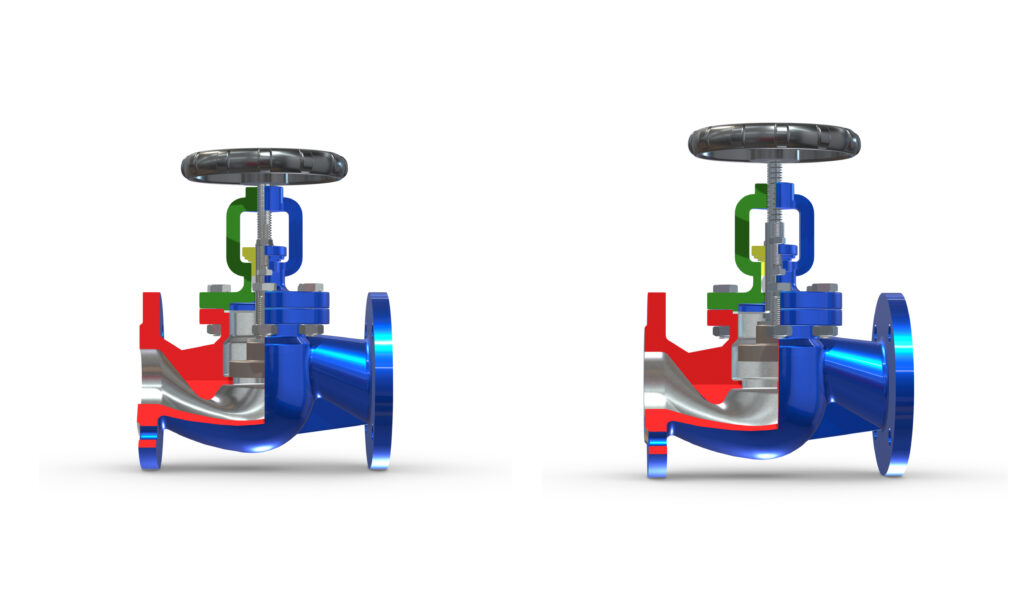Globe valves are a commonly used type of valve in the industry and are often used in applications where precise control of the flow or pressure of fluids or gases is required. This type of valve is widely used in industrial applications, including the oil and gas industry, chemical industry and power generation.

What are globe valves?
A globe valve is a type of valve that consists of a movable disc-like element (the valve) that moves up and down in a cylindrical housing. By moving the valve up and down, the flow of the medium in the pipeline can be controlled. Globe valves are typically used in situations where precise control of the flow or pressure of fluids or gases is required.
Operation of globe valves
Globe valves work based on a simple principle. When the valve is moved up, space is created between the valve and the seat, allowing the medium to flow through the valve. When the valve is moved down, the opening between the valve and the seat becomes smaller, and the flow of the medium is restricted or stopped.
Globe valves typically have a pivot point located between the valve and the valve body. The valve is usually operated using a handwheel, electric actuator, or pneumatic actuator. The handwheel is usually connected to a spindle that moves the valve up and down.


Advantages and disadvantages of globe valves
Globe valves offer precise flow control, easy operation, low pressure drop, and reliability, which make them well-suited for applications where precise control of fluid or gas flow is required. However, they also have some disadvantages, such as lower flow capacity compared to other types of valves, higher pressure drop, and higher costs. Therefore, when selecting a valve for a specific application, it is important to consider the required properties of the valve and weigh the advantages and disadvantages to determine if a globe valve is the best option for the job.
| Advantages | Disadvantages |
|---|---|
| Precise flow control | Lower flow capacity compared to other types of valves |
| Easy operation | Higher pressure drop compared to other types of valves |
| Low pressure drop | Higher costs compared to other types of valves |
| Reliability and long lifespan |
Globe valve 3D 360° View
Applications of globe valves
Globe valves are used in many different applications, including:
- Control Valves – Globe valves are often used as control valves in systems where precise control of the flow or pressure of the medium is required.
- Shut-off Valves – Globe valves are used as shut-off valves in systems where the medium needs to be completely shut off.
- Safety Valves – Globe valves can be used as safety valves in systems where excessive pressure needs to be relieved to prevent damage to the equipment.
- Steam Applications – Globe valves are often used in steam applications, where they are used to control the flow of steam in the pipelines.
Construction materials of gate valves
| Material | Description | Applications |
|---|---|---|
| Carbon steel | A widely used material due to its strength, durability, and affordability. It is resistant to corrosion, making it suitable for use in various industries, including oil and gas, chemical processing, and water treatment. | Oil and gas pipelines, chemical processing plants, water treatment plants |
| Stainless steel | This material is often used in applications where resistance to corrosion is essential, such as in the food and beverage industry, pharmaceuticals, and marine applications. It is more expensive than carbon steel but has superior corrosion resistance. | Food and beverage processing, pharmaceuticals, marine applications |
| Cast iron | A common material used for gate valves in low-pressure applications such as irrigation and plumbing. It is inexpensive and easy to cast but has limited strength and durability compared to other materials. | Irrigation systems, residential and commercial plumbing |
| Brass | This material is often used in low-pressure and low-temperature applications, such as residential plumbing, due to its excellent resistance to corrosion and its malleability. | Residential plumbing, low-pressure and low-temperature applications |
| Bronze | A material that is often used in seawater applications because of its excellent resistance to corrosion. It is also used in low-pressure and low-temperature applications such as residential plumbing. | Seawater applications, residential plumbing, low-pressure and low-temperature applications |
| PVC | A thermoplastic material that is often used in low-pressure and low-temperature applications such as irrigation and plumbing. It is lightweight, affordable, and has good chemical resistance. | Irrigation systems, residential and commercial plumbing, chemical processing plants |
International standards for globe valves
| Standard | Description | Countries |
|---|---|---|
| API 600 | Specifies the requirements for steel gate, globe, and check valves for sizes NPS 2 (DN 50) through NPS 24 (DN 600) for use in the petroleum and natural gas industries | United States, Canada |
| ASME B16.34 | Standard covers Class 150, 300, 600, 900, 1500, and 2500 steel globe, globe-style, angle, and gate valves with flanged or butt-welding ends | United States, Canada |
| DIN 3356 | Specifies the requirements for globe valves with flanged and butt-welding ends, and threaded and socket-welding connections | Europe, Germany |
| BS 1873 | Standard specifies steel globe and globe stop and check valves for petroleum, petrochemical, and allied industries | United Kingdom, Middle East |
| JIS B2071 | Specifies the requirements for steel globe valves for general service | Japan, South Korea |
| GOST 5762 | Specifies the requirements for steel globe valves with flange and butt-welding ends for general service | Russia |
| EN 13709 | Specifies requirements for globe valves with flanged or butt-welding ends, or threaded and socket-welding connections, for general purposes | European Union, United Kingdom |